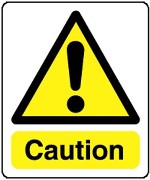 Jewelry stores have had many years to develop sales pitches and exaggerations that twist the truth in an effort to get you to buy a diamond they have in their display case. The following tricks and traps have been reported to us by clients all over the country.
Jewelry stores have had many years to develop sales pitches and exaggerations that twist the truth in an effort to get you to buy a diamond they have in their display case. The following tricks and traps have been reported to us by clients all over the country.
We are documenting some of the sad stories of what has happened to diamond shoppers who have been mistreated in jewelry stores. These stories can be found on our Buyer Beware page.
Remember, it is up to you, the diamond shopper, to be knowledgeable of what to ask and what to expect. Now you can be prepared for these tactics and not fall prey to them.
Make Them Show The Certification
If you are buying a diamond over a half carat for a ring, you should be buying a diamond certified by the GIA or AGS grading laboratories. When a jewelry store wants to sell you a diamond that is not certified, they really want the opportunity to exaggerate the color, clarity and cut grades. This is especially true if the diamond is already set in a ring. Unless you take the loose non-certified diamond to an independent appraiser, you have no way of knowing the true color, clarity and cut specifications.
You know you are in trouble if you ask a jewelry store sales person what color and clarity the diamonds are in a display case and they say everything is G/H color and “premium” clarity. Our experience is that most of those diamonds are J/K or at best I color and the clarity SI2 or lower. Without a certification, do not expect to find out what the depth percentage, table percentage or fluorescence level is and these can greatly affect the value of the diamond and the beauty.
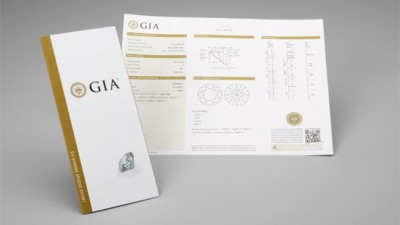 We hear stories almost daily about clients who shop in jewelry stores and are told the diamond is GIA certified. Yet they are never shown a copy of the certification even when they purchase the diamond. All too often the diamond turns out not to be GIA certified, but instead has some kind of appraisal document from the store with a signature of someone who took a class at the GIA. If they say the diamond is certified, ask not only to see at least a copy of the certification, but also get a copy for you to keep and review. If they will not do that, they must have something to hide and this should be your cue to exit the store as quick as you can.
We hear stories almost daily about clients who shop in jewelry stores and are told the diamond is GIA certified. Yet they are never shown a copy of the certification even when they purchase the diamond. All too often the diamond turns out not to be GIA certified, but instead has some kind of appraisal document from the store with a signature of someone who took a class at the GIA. If they say the diamond is certified, ask not only to see at least a copy of the certification, but also get a copy for you to keep and review. If they will not do that, they must have something to hide and this should be your cue to exit the store as quick as you can.
Beware of Life-Time Guarantee
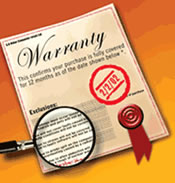 Beware of jewelers who stress their “life-time guarantee” for your ring. Ask to see the fine print of the contract so you can document what is and is not covered by their guarantee. Usually, they require you to get the diamond inspected by them every six months and are only responsible for loss of a diamond due to their negligence. We have yet to see their guarantee cover theft, loss or damage not related to the negligence with the setting. In other words, their guarantee probable only covers 5% or less of the things that might happen to your diamond ring. Since you have to have insurance for the 95% of other factors anyway, the guarantee does you little good other than to get you back in the store every six months. The sad thing is that the store never points this out and many of their customers fail to get insurance thinking they are protected for life. When their ring is stolen or lost, they learn the hard lesson about needing to read the fine print.
Beware of jewelers who stress their “life-time guarantee” for your ring. Ask to see the fine print of the contract so you can document what is and is not covered by their guarantee. Usually, they require you to get the diamond inspected by them every six months and are only responsible for loss of a diamond due to their negligence. We have yet to see their guarantee cover theft, loss or damage not related to the negligence with the setting. In other words, their guarantee probable only covers 5% or less of the things that might happen to your diamond ring. Since you have to have insurance for the 95% of other factors anyway, the guarantee does you little good other than to get you back in the store every six months. The sad thing is that the store never points this out and many of their customers fail to get insurance thinking they are protected for life. When their ring is stolen or lost, they learn the hard lesson about needing to read the fine print.
Do The Math for Trade In
 Do not fall for the sales pitch that you can always trade your diamond in for an upgrade. Simply do the math and you will see that if you pay more for a diamond now and more for an upgrade later, trading in your diamond for what you paid for it is not a good deal. You are always better off to buy your first diamond at the best price possible and then buy your upgrade diamond at the best price too.
Do not fall for the sales pitch that you can always trade your diamond in for an upgrade. Simply do the math and you will see that if you pay more for a diamond now and more for an upgrade later, trading in your diamond for what you paid for it is not a good deal. You are always better off to buy your first diamond at the best price possible and then buy your upgrade diamond at the best price too.
Here is an example of how the math really works. Suppose you bought a diamond in a jewelry store for $5,000 ten years ago and now want to upgrade to a diamond the store is selling for $20,000. They credit you for $5,000 and you pay $15,000. However, the diamond you bought ten years ago was priced $1000 too high then and the new diamond is priced $3,000 too high now. You are much better off paying $17,000 for the new diamond, selling your old diamond for $6000 since it has appreciated in value these last ten years. The net cost is only $11,000 to you, not $15,000. Many times our clients tell us about “trade in” deals offered by their local jeweler that cost them more than if they simply kept their old diamond and bought the new one from us.
You Deserve the Best
A classic sales tactic in a jewelry store is to show you three diamonds with characteristics similar to what you are looking for. Then they try to get you to buy the best of the three. What are the odds that this particular store has the three best diamonds on the market? Often you are simply picking an average cut diamond over two poorly cut stones. What you really want is to be picking the best diamond on the nationwide market. You deserve the best of the best, not the better one of three mediocre stones.
Ask yourself this question. What is the likelihood that this particular jewelry store happens to have the three best diamonds in the country that meet your shopping requirements? You deserve the best and the only way to do that is to search the entire wholesale market for the best diamond meeting your requirements.
You See Size, Not Weight
When shopping for a diamond, focus on millimeter size rather than carat weight. This is especially true for diamonds that are not certified or where the millimeter measurements are not displayed to you. Jewelry stores tend to buy the cheapest diamonds they can for their inventory with the hopes of “selling” them to a shopper. One way to buy cheaper diamonds is to get those that are cut too deep and thus small in size for the carat weight.
Often the diamonds weighing one carat in a store’s display case will measure 6.2 to 6.3 millimeters which is closer what a 0.85 to 0.9 carat round should measure. Somehow, the sales clerk forgets to mention that the one carat diamond really looks like a 0.85 carat size. If you are paying for a one carat, you want it to look like a one carat, otherwise buy a 0.85 carat and save $1000.
Sale Price Might Not Mean Good Value
 Which diamond is the better value, one that priced at $5,000 marked down from $10,000 or one that is priced at $6,000 marked down from $12,000? The answer is that you have no idea. The high list prices and big discount markdowns are a game to make you think the diamond is somehow worth more than its price. The only factors important to value are the price you can purchase relative to the quality and size of the diamond. We think this game is an insult to customers. Who are the fools buying at those high prices and if no one ever buys at those prices, why have them listed.
Which diamond is the better value, one that priced at $5,000 marked down from $10,000 or one that is priced at $6,000 marked down from $12,000? The answer is that you have no idea. The high list prices and big discount markdowns are a game to make you think the diamond is somehow worth more than its price. The only factors important to value are the price you can purchase relative to the quality and size of the diamond. We think this game is an insult to customers. Who are the fools buying at those high prices and if no one ever buys at those prices, why have them listed.
The real way to determine value is to compare prices for the same or similar diamonds from other sources. If the diamonds above can be purchased for $4,000 and $5,000 at other sources, they would not appear to be good values, just old marketing tricks.
Separate Fact from Fiction
Reading the information in our Education section will help protect you from false statements by jewelry store clerks. Here are some of the false claims our clients have reported they heard in jewelry stores.
How does clarity relate to color?
- Fiction: High clarity will compensate for lower color.
- Fact: The clarity has no impact on color. Obviously the store clerk had a low color, high clarity diamond in their inventory and they were willing to say anything they could to sell it.
Is “direct from the cutter” better?
 Fiction: We get our diamond direct from the cutter so our prices are lower.
Fiction: We get our diamond direct from the cutter so our prices are lower.- Fact: Their price has more to do with their overhead and the quality of the diamond, rather than where they bought the diamond. If they are selling to the public, they are retailers no matter what they might call themselves. You are looking for value which is a comparatively low price for the high quality and big size you want.
Does big table mean size?
 Fiction: A big table makes the diamond look bigger.
Fiction: A big table makes the diamond look bigger.- Fact: Those making this claim are just trying to sell poorly cut diamonds. It is the length and width of the diamond that you see that are the visible size. Smaller table percentages generally produce better cut diamonds. Bigger tables do not make a diamond look bigger. You want to find a big millimeter size for the carat weight but still have great cut proportions.
What is that dark shadow in the diamond?
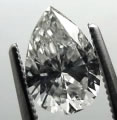 Fiction: The bow tie in fancy shape diamonds indicates good cut.
Fiction: The bow tie in fancy shape diamonds indicates good cut.- Fact: The bow tie shadow in fancy shape diamonds is a sign that the facets were not cut as good as possible and the diamond is not uniformly bright from end to end. A diamond with minimal bow tie is one cut properly for maximum brilliance.
Know What Ideal Cut Is
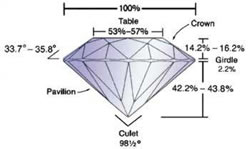 When a jeweler says every diamond he has is ideal cut, you immediately know that retailer is trying to push poor or average cut diamonds on you and hopes you are not knowledgeable enough to know the difference. We had a local client tell us that one of the jewelry stores in our area told him a round diamond with a 64% table was ideal cut. Fortunately, our client had done some research and knew better.
When a jeweler says every diamond he has is ideal cut, you immediately know that retailer is trying to push poor or average cut diamonds on you and hopes you are not knowledgeable enough to know the difference. We had a local client tell us that one of the jewelry stores in our area told him a round diamond with a 64% table was ideal cut. Fortunately, our client had done some research and knew better.
Beware of Jewelers Appraising Your Diamond
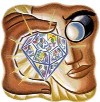 If you want another opinion on your diamond, it is always best to find an independent appraiser to examine your diamond. By independent, we mean someone who is not selling diamonds. You want an honest, un-biased and professional opinion and that is difficult to do if the person sells diamonds and thinks that by saying something negative about the diamond you bring in they might have a chance of selling you something in their display case.
If you want another opinion on your diamond, it is always best to find an independent appraiser to examine your diamond. By independent, we mean someone who is not selling diamonds. You want an honest, un-biased and professional opinion and that is difficult to do if the person sells diamonds and thinks that by saying something negative about the diamond you bring in they might have a chance of selling you something in their display case.
If you can not find an independent appraiser in your area and you want to take the diamond to a jewelry store, it is helpful to know what to look for and what to expect. First of all, remember most people working in jewelry stores are “tag readers” who have no formal training in diamond grading. Be sure you find someone that has at least taken the diamond grading courses at the GIA and has a microscope, a master set of color grading stones and a digital millimeter gauge. They should involve you in the examination and let you examine the diamond under the microscope.
Keep in mind, someone in a jewelry store desperately wants to sell you one of their diamonds. It is kind of like a shopper bringing a Dell computer to a Gateway computer store and asking them what they think of the computer. Do not expect them to point out the positive aspects, only the negative. You can also expect them to even stretch the truth if they think it might turn into a sale for them. It is just human nature to be biased when there is a conflict of interest.
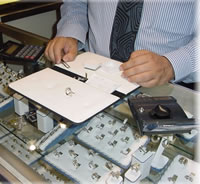 Do not expect to say you got this diamond from an online diamond retailer and still get a fair assessment of the diamond. Jewelry stores historically had a “license to steal” since they had no competition for selling diamonds. In past years they often doubled and even tripled the price. However, the competition and information available online today has greatly reduced their profits and sales so now they are just plain mad. Mention the word internet to a jewelry store owner and they start boiling because online competition has turned their life up side down. They just want things back the way they use to be where the customers knew nothing about diamonds and paid the asking price because there was no competition.
Do not expect to say you got this diamond from an online diamond retailer and still get a fair assessment of the diamond. Jewelry stores historically had a “license to steal” since they had no competition for selling diamonds. In past years they often doubled and even tripled the price. However, the competition and information available online today has greatly reduced their profits and sales so now they are just plain mad. Mention the word internet to a jewelry store owner and they start boiling because online competition has turned their life up side down. They just want things back the way they use to be where the customers knew nothing about diamonds and paid the asking price because there was no competition.
Beware of the following tactics that have been reported to us by our clients who took diamonds to a jewelry store to get an opinion.
Promises but no follow through. We frequently hear about a store owner saying they can get a better diamond for less money. If they could why are all the diamonds in their store so much more expensive? We recently had a store tell our client that our D color, Internally Flawless, Ideal cut, Hearts & Arrows diamond was about double the price he could get it for. It is easy for them to say they can produce a better diamond, but they never do. Tell them they have two hours to get you a copy of a certification for a better diamond at a lower price and watch them backtrack.
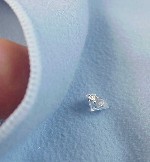 Dirty fingers. When examining a diamond with a microscope, it is important to keep it very clean. An old jewelry store trick is to touch your diamond with their fingers so the oil and dirt on it makes it look dull. Then they show you one of their diamonds and it looks shiny and clean.
Dirty fingers. When examining a diamond with a microscope, it is important to keep it very clean. An old jewelry store trick is to touch your diamond with their fingers so the oil and dirt on it makes it look dull. Then they show you one of their diamonds and it looks shiny and clean.
 Bad tools. We often hear back from a client that the jewelry store owner measured the diamond and it was not what the certification said so they doubt it is the right diamond. While digital millimeter gauges can vary a few hundreds of a millimeter, store owners often use cheap brass measuring devises that are very inaccurate. By measuring the wrong part of the diamond with a bad device, they hope to put enough doubt in your mind to not buy the diamond.
Bad tools. We often hear back from a client that the jewelry store owner measured the diamond and it was not what the certification said so they doubt it is the right diamond. While digital millimeter gauges can vary a few hundreds of a millimeter, store owners often use cheap brass measuring devises that are very inaccurate. By measuring the wrong part of the diamond with a bad device, they hope to put enough doubt in your mind to not buy the diamond.
![]()
Color comparisons. Another old jewelry store trick is to control the color of the comparison stone. They pull a diamond out of some tissue paper and say it is a particular color. Then they show you how your diamond does not look as white and therefore must be the wrong color grade. What you don’t know is what the true color of that stone was, if it had fluorescence or if they were viewing the color correctly (from the side against a white background). If the comparison stone is not a color grading stone approved by the GIA, you don’t know what they are showing you.
Off center. We have recently had several jewelry stores say diamonds were off center. They simply tilted the diamond a little under the microscope so the center of the diamond appeared to be a little to one side. Fortunately our client knew that an AGS triple ideal cut diamond would not be “off center.”
Your Princess Cut Diamond is Not Square. A common scare tactic used by jewelers looking at someone else’s princess cut diamond is to point out that the diamond is not a perfect square with length not exactly equal to width. They imply that because the length does not equal the width, they will not be able to set the diamond properly. The reality is that the GIA defines a diamond to be “square” if the length to width ratio is 1.05 or less. Measurements on the GIA grading report are listed in hundreds of a millimeter so while the numbers for length and width might seems different, if the length to width ratio is less than 1.05, the diamond will look square to the eye. When setting a diamond in a mounting, the prongs are usually adjusted to fit the diamond so a few tenths of millimeter difference between length and width is not a problem. From a beauty aspect, even princess cut diamonds that are rectangular can have a gorgeous facet pattern if cut right so do not fall for this scare tactic.
Your Princess Cut Diamond is Too Shallow. Most jewelry stores buy very deep princess cut diamonds for their inventory because they are less expensive compared to princess cut diamonds with great cut providing beauty and big millimeter size for the carat weight. They often will use the scare tactic of saying your princess diamond is too shallow. The reality is probably that their princess cut diamonds are too deep. If the depth percentage of your princess cut diamond is in the 60% to 76% range you are in the right depth range to get the big, beautiful look for your princess diamond. Trust your eyes to tell you if the diamond has lots of brilliance and sparkle, not the generic comment of the jeweler saying it is too shallow compared to what they have in their display case.
Warped diamond. We have had several clients who had jewelers take a diamond in to be put in a setting and the jeweler told them it was a “warped” diamond. You can imagine their concern, especially when several of these diamonds were AGS triple ideal cut stones. Jewelers using the warped diamond trick tell the person bringing a diamond into their store that the crown, girdle and pavilion percentages do not add up right. They pull out their pencils and show that certain numbers do not add up to the total. Amazingly, only diamonds in their display case are not “warped” diamonds. While diamonds might be out of round or even lop sided, there are no “warped” diamonds so beware if you hear this term used.
Bonded Diamonds. Interestingly, the person who invented the “warped” diamond also came up with another sales pitch called the “bonded” diamond. That person published a book on how to buy diamonds and cleverly stated that diamond shoppers should only purchase a bonded diamond. Since he was the only retailer using that term, he was saying the only place you should buy a diamond is his store. Even the author points out that “bonded” diamonds will be 10-15% more expensive than a non-bonded diamond. Like most sales pitches, the claims for bonded diamonds are long on promises and short on real benefits. What value is a promise to exchange a broken diamond if your insurance company will do that too and give you the current value? What value is a promise to allow you to upgrade if you can broker the diamond with us and maybe get more than your original cost? What value is a promise to sell natural and untreated diamonds when that is what a GIA Diamond Grading Report ensures? In other words, you are paying a 10-15% premium for your “bonded” diamond with little, if any, real value for you as a consumer. Focus on the value of the diamond, not the sales hype and empty promises.


